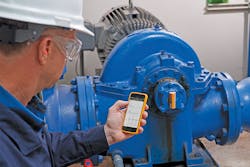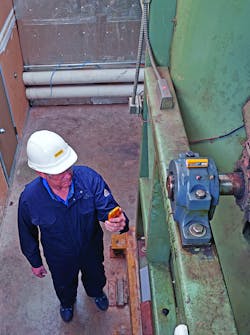Connected assets and remote monitoring improve safety and efficiency
While the term Internet of Things (IoT) has been around for a while, the concept of the Industrial Internet of Things (IIoT) is newer. Only during the last five years have more developments occurred in the industrial world; however, IIoT can be applied across many applications and industries. Recently, the maintenance and reliability (M&R) sector has begun to take advantage of these technologies.
By connecting the digital and physical worlds, information exchange can be improved and elevated within industrial maintenance applications. In this context, "digital" includes smart devices, computers and software, while the "physical" world encompasses plant assets and testing and monitoring hardware. IIoT helps plants and facilities increase visibility into machine performance and health, inefficiency in processes and potential savings. It offers other benefits, including personnel and asset safety.
Different industries use the power of IIoT in diverse ways, such as:
• M&R teams use vibration analysis, infrared sensors, ultrasound and power monitoring, among other technologies, to determine when conditional changes occur. They use this data to schedule maintenance before downtime occurs.
• With fully connected IIoT devices, plant and maintenance managers, technicians and the entire plant have access to data in real time and turn data into actionable methods to not only prevent failures but also predict them.
• Remote monitoring technologies keep personnel away from dangerous rotating assets and allow them to stay outside arc flash zones.
Improved personnel and asset safety
In industrial plants and other facilities, safety is of paramount concern. Many assets may present dangers if personnel must be in close proximity to take measurements. Some of these include:
• Rotating assets, such as pumps, fans, blowers and motors
• Hot assets, such as furnaces, ovens, heat exchangers, process piping and large motors
• Electrical panels, from which arc flash can occur
Monitoring with wireless sensors — made easier and more affordable with IIoT — allows technicians and other personnel to remain a safe distance from equipment in operation. They receive alarms on their smart devices if power fluctuates or drops (power monitoring), vibrations exceed conditional norms (vibration monitoring), a hazardous gas leak begins (ultrasound) or temperatures move outside safe parameters (thermal/infrared sensors).
Monitoring with wireless sensors allows technicians and other personnel to remain a safe distance from equipment in operation.
Personnel receive the information needed to make informed decisions. One action could be deciding that the abnormality is not severe enough for intervention. Another may be scheduling downtime to make a repair or replace a part. Regardless of the action taken, M&R teams have the knowledge and control to choose when intervention is required, preventing unscheduled downtime and increasing the proper operation of assets.
Proper operation not only ensures asset health but also prevents other personnel risks. Failing equipment can cause catastrophic damage to facilities and personnel who may be nearby when the failure occurs. Maintaining appropriate operation mitigates personnel and property hazards as well.
Maintained asset health
When applied to maintaining asset health, IIoT helps M&R teams break new ground. M&R systems are not an all-or-nothing implementation. Pieces and parts of a system may be added to the technology lineup at different times. Some measurements may be gathered on preventive routes with handheld devices. Other measurements can be taken by wireless sensors and still others by tools already installed on the asset. The ability to use IIoT technology to aggregate data from different measurement devices is instrumental to the often-small steps that many M&R teams must take as they begin the reliability journey.
The addition of wireless sensors can be a first step from preventive maintenance to predictive or condition-based strategies by taking measurements that are sent to the cloud. Some technologies that can provide early warning of imminent problems include thermal imaging sensors, vibration sensors, power monitoring and ultrasound.
Increased efficiency and time savings
Reactive and preventive M&R activities are time- and labor-intensive. Emergency repairs and ordering parts take time and personnel away from activities that help prevent downtime. This can become a circular problem as preventive activities and time-based tasks are missed and technicians carry out reactive work to get assets back to normal operation. As a result, more unplanned failures may occur.
Preventive and time-based tasks, which are required in many facilities and plants and are legitimate maintenance strategies, require dedicated staff to perform them. Among the many reasons that M&R teams should begin to limit this type of work include:
• About 80 percent of assets examined during time-based routes are healthy and operating normally. Time is wasted monitoring healthy equipment.
• Personnel must be in close proximity to assets, increasing the risk of injuries or accidents.
• Compiling data from these activities may be error-prone and spotty.
Implementing remote, wireless monitoring helps teams screen equipment in real time. This allows the M&R team to identify any assets that are experiencing problems and focus their activities on those assets.
Connected reliability
Ultimately, IIoT allows for connected reliability, which removes the major barriers that prevent implementing IIoT and often confound predictive maintenance initiatives. These barriers include:
• Missing or inaccessible data and reliance on scheduled routes
• Lack of connectivity between assets, management systems and M&R teams
• Limited access to relevant data for timely, informed decisions on the plant floor
To move past reactive strategies and manual data entry, facilities need connected reliability — a framework to connect assets, systems and people. Connected reliability gives teams a customizable way to make a quantum leap to a more reliability-focused reality. A connected reliability framework must consist of three essentials:
• Comprehensive data collection
• End-to-end connectivity
• Empowered teams
M&R teams must be able to use all data types and sources so they can use IIoT wherever they may be in the reliability journey. Whether using handheld tools, a wireless sensor, supervisory control and data acquisition (SCADA) or any other condition/process data, this multisource information must be aggregated and stored for future study and analysis. This stored data must function in lock-step with an enterprise asset management or computerized maintenance management software system. With this integration in place, data can be available to the right people at the right time to improve safety, efficiency and asset health.
The ultimate goal of connected reliability is full-time access to the data and analysis needed by those charged with assuring asset health so that they successfully meet their goal: equipment reliability. Providing continuous, actionable data to the M&R team is the final and most important piece of connected reliability. Teams will have access to the data they need to work safely and efficiently to maintain asset health.
Alex Desselle is a product application specialist with Fluke Digital Systems and Accelix. With more than 30 years of experience, Desselle has been a lead field engineer, product manager and subject-matter expert in the oil and gas, chemical and manufacturing industries. He may be reached at [email protected]. For more information, visit fluke.com.


